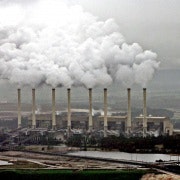Napthine produces a sceptic's energy policy plan
The Victorian Energy Minister Russell Northe released Victoria's Energy Statement yesterday, confirming an ambition to lock in brown coal and gas as the state's principle sources of electricity. It is the energy statement that the fossil fuel industry has been wishing for.
The statement is profoundly disappointing. It is a mixture of missed opportunities and deliberate decisions to block energy efficiency and undermine renewable energy. Overlaying it is empty rhetoric about empowering consumers.
Although Northe claims that Victoria will ‘lead Australia' on energy policy, the fact is that the Victorian government's 1985 energy statement showed more ambition and forward thinking, especially on renewable energy, than this one.
There are three key areas where the energy statement is worrying.
Firstly, the statement confirms that the Victorian Government would lock in brown coal as principle source of energy for the state and, worse, seek to create an export industry.
The stated policy objective for the government is to "accelerate the development and adaption of technologies … to commercialise brown coal". This attitude towards the most polluting source of electricity in the world could only be proposed by a government that is sceptical about the reality of global warming. Furthermore, there is no commitment to maintaining the moratorium on onshore gas developments (‘fracking') beyond July 2015, an omission that should worry Victoria's farming and regional communities.
Currently the vast majority of Victoria's electricity (84 per cent) comes from burning brown coal, an unacceptably high level if Victoria and Australia have real ambitions to reduce our carbon pollution and transition to a clean energy economy. The energy statement says nothing about driving the transformation towards renewables.
Secondly, developing Victoria's renewable energy capacity is not one of the seven energy priorities in the statement. The few times that renewable energy projects are mentioned in the statement are highly qualified or simply describing investments that occurred despite the hostile attitude of this government.
While polling shows that four out of five Victorians support renewable energy, the energy statement admits that Napthine Government has reduced solar feed-in tariffs, restricted the development of new wind farms and argued for the weakening of the national renewable energy target.
Perhaps the strongest signal of all is that none of the government's objectives for ‘energy technology innovation' refer to renewable energy. Brown coal commercialisation on the other hand gets first billing.
Finally, the statement obscures its dismantling of Victoria's pre-2010 energy efficiency policies through disingenuous consumer-empowerment rhetoric.
The final remaining policy, the Victorian energy efficiency target, is slated for closure (if the government gets its way in Parliament this week) in 18 months and will be dramatically scaled down next year.
The target has been highly effective in reducing energy bills, especially for low-income Victorians, and more than 2000 private sector jobs rely directly on the program's continuation. The energy efficiency target has since 2009 put efficiency measures directly into over 1.4 million homes, and has reduced energy consumption by 14 percent (a saving of $308 on bills).
A range of other schemes that provide direct assistance and incentives to improve energy efficiency in commercial buildings and homes, improvements to government building, and solar hot water incentives, have all been abolished or mothballed over the last four years.
In their place, the Napthine Government is proposing the creation of a series of websites to increase information to consumers and encourage energy retailer switching. It is indicative of this government's attitude to energy efficiency that they have decided to remove programs that had real, tangible benefits – both on reducing costs and reducing carbon pollution emissions.
Victorians rightly expect the state government to play a role in improving energy efficiency. The Napthine Government has decided to give up and leave consumers to fend for themselves against energy retailers, armed only with the ‘My Power Planner' website and alliance star ratings.
There are numerous other concerns that Environment Victoria has with this energy statement. It contemplates further wasting taxpayer funds on carbon capture and storage, despite the fact that no Australian generators are prepared to invest in the technology. It proposes the expansion of natural gas infrastructure, despite the expected price hikes due when we transition to the global market. It has no vision for the Latrobe Valley beyond further fossil fuel extraction.
The foundation for this statement is unfortunately clear. This is a government actively and ideologically committed to coal and gas, and opposed to renewable energy. Victorians should rightly expect more from a government that was elected in 2010 on commitments to support a low carbon future.
Alex White is campaigns director for Environment Victoria, a not-for-profit charitable group and Victoria's peak non-government environment organisation.
*EV has prepared a critique of the Napthine Government's clean energy and energy efficiency policy suite: 'Sun Blocks, Wind Breaks'.















